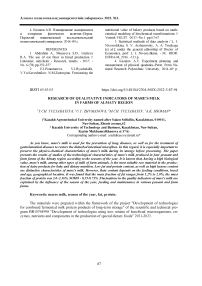Research of qualitative indicators of mare’s milk in farms of Almaty region
Автор: Tultabayeva T. Ch., Zhumanova U. T., Tultabayev M. Ch., Shoman A. K.
Журнал: Вестник Алматинского технологического университета @vestnik-atu
Рубрика: Технология пищевой и перерабатывающей промышленности
Статья в выпуске: 3 (137), 2022 года.
Бесплатный доступ
As you know, mare's milk is used for the prevention of lung diseases, as well as for the treatment of gastrointestinal diseases to restore the disturbed intestinal microflora. In this regard, it is especially important to preserve the physico-chemical characteristics of mare's milk during its storage before processing. The paper presents the results of studies of the technological characteristics of mare's milk produced in four peasant and farm farms of the Almaty region according to the seasons of the year. It is known that, having a high biological value, mare's milk, among other types of milk of farm animals, is the most suitable raw material in the production of dairy products for baby and dietary nutrition. Low fat and protein content, as well as high lactose content are distinctive characteristics of mare's milk. However, their content depends on the feeding conditions, breed and age, geographical location. It was found that the mass fraction of fat ranges from 1.2 % to 2.8 %, the mass fraction of protein was 2.0-2.36 %, SOMO - 8.35-8.73 %. Fluctuations in the quality indicators of mare's milk are explained by the influence of the season of the year, feeding and maintenance in various peasant and farm farms.
Mares milk, season of the year, fat, protein
Короткий адрес: https://sciup.org/140295741
IDR: 140295741 | УДК: 65.63.03 | DOI: 10.48184/2304-568X-2022-3-87-94
Текст научной статьи Research of qualitative indicators of mare’s milk in farms of Almaty region
IRSTI 65.63.03
Justification of the choice of the article and goal and objectives
In Kazakhstan, there are currently about 100 farms with various forms of ownership specializing in horse breeding and production of mare's milk, which is not enough to eliminate the shortage in mare's milk, which is of high biological value compared to cow's milk [1,2]. For example, according to the Bureau of National Statistics, 27.6 thousand tons of mare's milk were produced in Kazakhstan in 2019. The main volume fell on the Karaganda region (7,490.4 tons), Turkestan (5,931.7 tons) and East Kazakhstan (2,861.8 tons) next are Zhambyl (2,367.3 tons) and Almaty regions (1,846.8 tons) [3].
As you know, the chemical composition of mare's milk consists of several components: fats, proteins, carbohydrates, various minerals, enzymes, vitamins, trace elements [4, 5]. It is due to the variety of components that milk is the most important food. It should be noted that the components that make up mare's milk are in such proportions, have high digestibility and assimilation. However, the chemical composition of milk does not remain constant and varies depending on the physiological state, feeding conditions, maintenance, breed and age of animals, as well as the location of animals [6, 7].
The analysis of the published results of physico-chemical composition of mare's milk in various regions of Kazakhstan showed discrepancies in the indicators of its main components (mass fraction of fat, protein, lactose) [4-9, 5].
The above contradictions from scientific sources of information data indicate the need to conduct studies of the physico-chemical composition and sanitary-epidemiological indicators of mare's milk from different farms to select the optimal technological scheme for its further processing [5, 6].
Materials and Research Methods
Physico-chemical parameters of mare's milk were determined according to the requirements set out in the following regulatory document:
GOST R 52973-2008 «Mare's raw milk. Specifications» the Eurasian new GOST has not yet been approved, which establishes technical requirements for raw mare's milk intended for industrial processing [10];
The active acidity was determined by a potentiometric method using a laboratory device pH meter HI 99161 with an electrode FC202D in accordance with GOST 32892-14 "Milk and dairy products. Method ofmeasuring active acidity" [11];
The determination of lactic acid microorganisms was carried out using microbiological methods according to GOST 33951-2016 "Milk and dairy products. Methods for the determination of lactic acid microorganisms"[12];
Yeast according to GOST 33566-2015 "Milk and dairy products. Determination of yeast and mold fungi"[13];
Results and their discussion
The special attention is paid to the content of biologically complete components of milk [614]: protein, fat and skimmed milk residue (SMR) in mare's milk [5, 14-16].
The aim of the work was to study the chemical composition of mare's milk produced by the seasons of the year in the farms of the Almaty region. The content of milk components was studied in average samples every month in 3-5 fold repetition according to generally accepted methods [4,18].
The quality ofthe collected mare's milk was analyzed monthly by sampling from every 5 milkings from March to October during the year.
Laboratory studies of the selected samples were carried out stationary using the device "LactoSTAR". The results of determining the mass fraction of fat, protein and SMR mare's milk by seasons from different farms of the Almaty region are shown in Figure 1.
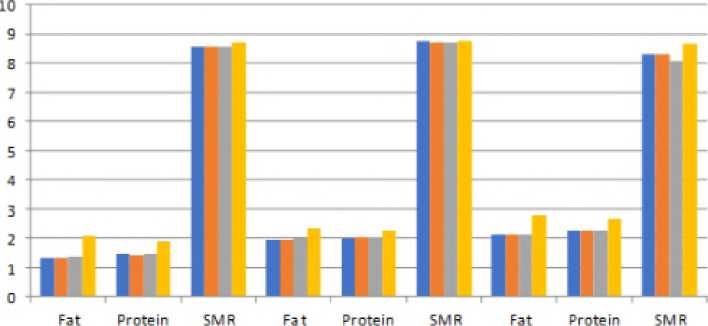
springperiod summer period autumn
period ■ PF "Erlik* вРҒ *Tyfiys" ■ PF’ Makhanov LT IE "Saumal Deluxe"
Figure 1 - Chemical composition of mare's milk by seasons
The data obtained (Figure 1) indicate that the chemical composition of mare's milk is relatively stable for months. The average monthly indicators of fat in milk range from 1.2-2.8% [5, 19]. The maximum average fat content is noted in the autumn months, in second place - in the summer. The tendency to increase the fat content of mares by the end of the pasture and lactation periods (September-October) is well expressed in the combined milk. The average protein content in mare's milk for the year was 2.0% with fluctuations. In the context of months, the average indicator was the lowest in the spring period (1.56%) and the highest in the autumn period (2.36%). The indicator ofthe content of dry fat-free substance is on average quite stable and varies seasonally between 8.35-8.73% [5, 19-22]. The maximum amount of dry matter was observed in the summer period, the minimum in October milk. Consequently, in the pasture season, especially from July to September, mares receive the most valuable dairy raw materials in terms of nutritional proper-ties[5, 19].
A comparative analysis of the data obtained showed that there is a slight difference in the quantitative content of the component composition of mare's milk from different farms, taking into account different levels of feeding and conditions of keeping animals, but the nature of their changes is almost the same [5, 6].
The deterioration in the quality of milk at the stall content is associated with a decrease in the level of feeding and the range of feeds, which can be compensated to a certain extent by optimizing feeding during this period ofthe year [5-9,15].
Acidity is the main chemical property of milk and its important technological indicator, since certain acidity indicators are required for the production of various dairy products [1922,6]. The total (titrated) acidity of milk is due to the content of proteins, acid salts and gases in it. The acidity is determined by titration with alkali in the presence of phenolphthalein. The acidity of mare's milk during the year was determined by monthly analyses of samples of milk from March to October (Figure 2)[2, 5-6].
?
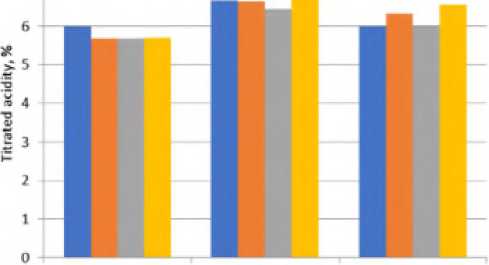
■ PF "Erlik"
■ PF "Tynys"
■ PF "Makhanov u"
IE" Sauitial Deluxe"
spring summer autumn
Season of the year
Figure 2 - Dynamics of changes in titrated acidity of mare's milk by seasons
Moreover, proteins [24], carbohydrates and salts increase this indicator, and fat lowers it. The density of mare's milk was sufficiently stable, and its indicators for the seasons ranged from 1029.3 to 1034.1 kg/m3 (Figure 3).
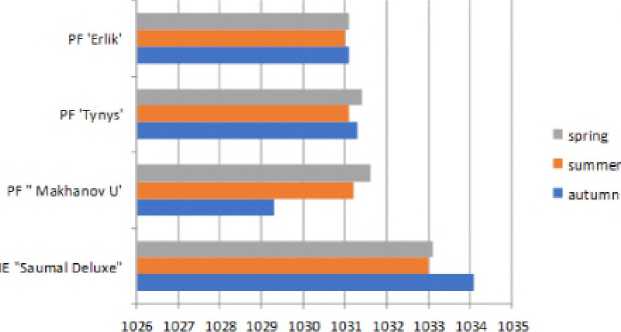
Figure 3 - Dynamics of changes in the density of mare's milk by seasons
Milk fat is an energy component of milk. 9.3 kcal of energy are obtained from one gram of fat. Milk faa is subject to changes under the influence of various factors and may increase or decrease under the influence of the type of feeding, lactation period, physiological state of the animal, climatic conditions, etc. [5-9]. The content of milk fat varies significantly depending on the season of the year [27, 28]. Despite the fact that in our studies the animals were kept in year-round stable all year round, the mass fraction of fat was in spring -3.88±0.02%; in summer -3.74±0.003%**, in autumn -3.92±0.02%; in winter -3.93±0.02% (Figure 4). The difference is significant in winter and summer (P<0.001). The average fat content for the year was 3.84±0.07%. The reduction of fat content in summer is lower than the annual average by 0.2%. This decrease is explained by an increase in the ambient temperature in the room [5, 28].
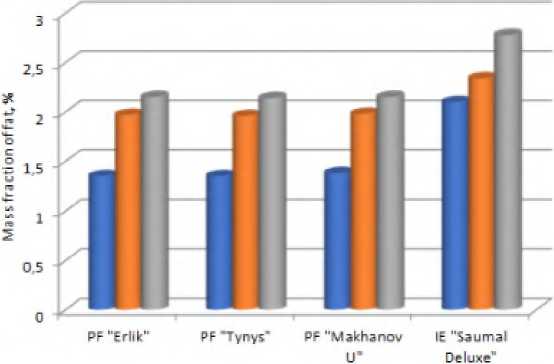
■ sun ПЕ
■ summer
■ autumn
Figure 4 - The content of the mass fraction of fat in mare's milk
The results of our research allow us to conclude that the SMR changes according to the seasons of the year (Figure 5). There is the highest SMR content in milk in summer; the lowest in spring.
In spring, the content of individual components and the total amount of dry matter is 1.1% less than in summer; in autumn, it is 3.5% lower compared to the summer period. A high content of SMR in milk was noted at the farm of PF "Saumal Deluxe", such differences can be explained by the influence of feeding in various farms [29].
8,8
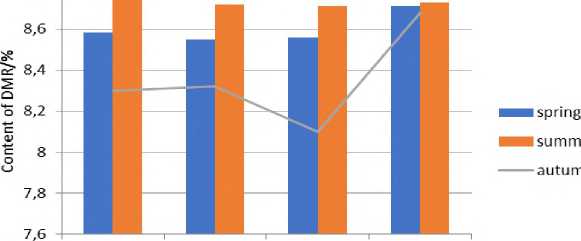
PF "Erlik' PF'Tynys" PF IE "Saumal "Makhanov Deluxe”
U"
Figure 5 - The content of skimmed dry residue in mare's milk
After visual identification and microscopy, colonies of lactic acid microorganisms were selectively transplanted to a pure nutrient selective medium [30-31]. This process was repeated until the colony of lactic acid microorganisms was completely microbiologically clean. The morphology of the studied strains and microbiota of mare's milk were studied by traditional methods using the Motic VAZ 310 electron microscope [32-37].
The peculiarities of the growth of microorganisms in mare's milk (differential medium, MRS) were studied (Figure 6).
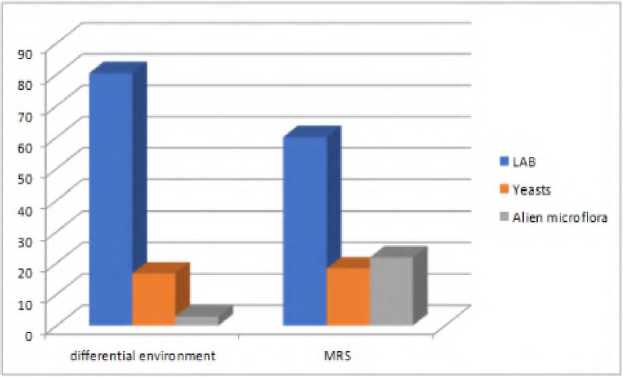
Figure 6 - Microflora of mare's milk, features of growth on different media
According to the study, it is shown that the mare's milk LAB grows well in a differential environment compared to MRS. And the foreign microflora shows good growth on MRS, whereas yeast in these media shows the same average growth [38-39].
Conclusions
The decrease in milk quality depends on the sanitary and hygienic conditions of production, the primary processing of raw materials on a dairy farm and has no seasonal pattern.
As a result of the conducted studies of the qualitative indicators of mare's milk, selected from different farms and peasant farms and in different seasons of the year, it shows that the physicochemical indicators of mare's milk depend on feeding and animal conditions. So it can be noted that mare's milk from the farm of IE "Saumal Deluxe" is characterized by a high content of the mass fraction of protein (2%) and fat (2.8%). In the other three farms, the indicators are identical and do not have large discrepancies.
Thus, it can be concluded that mare's milk is suitable for use as a raw material for the production of combined dairy products enriched with vegetable additives for dietary nutrition according to its organoleptic, physico-chemical properties.
Список литературы Research of qualitative indicators of mare’s milk in farms of Almaty region
- Navraltilova P. Content of nutritionally important components in mare milk fat // Mjekarstvo. - 2018. - Vol. 68 (4). - Pp. 282-294
- Guo L. Priduction technology, nutritional, and microbiological investigation of traditionally fermented mare milk (Chigee) from Xilin Gol in China // Food Science and Nutrition.- 2019. - Pp. 1-8.
- Electronic resource. https://stat.gov.kz, Access date 01. 12. 2021.
- Markiewicz M. K. Influence of stage of lactation and year season on composition of mares’ milk colostrum and milk and method and time of storage on vitamin C content in mares milk // J Sci Food Agric. - 20199. - 95.- Pp. 2779-2286.
- Aitimova D. N., Tultabayeva T. Ch., Zhonysova M. U. Study of the quality of mare's milk as a raw material for the dairy industry // Vestnik ATU, No. 4 (2018), Pp. 35-38.
- Kanarekina S. G. Dynamics of the chemical composition of mare's milk by seasons of the year // Izvestiya Orenburg State Agrarian University. - 2010. - Vol. 3. - No. 27 - Pp. 105-107.
- Bogdanovicova K. Microbiological Quality of Raw Milk in the Czech Republic // Food Microbiology and Safety. - 2016. - 34. - Pp. 189-196.
- Yakunin A. V., Sinyavsky Yu. A., Ibraimov Y. S. Assessment of the nutritional value of mare's milk and fermented milk products based on it and the possibility of their use in baby food. Issues of modern pediatrics. 2017; 16 (3): 235-240. URL: https://vsp.spr-journal.ru/jour/article/view/1760?locale=en_US
- Tultabayeva T. Ch., Abay G. K. Prospects for the use of mare's milk for children's and dietary nutrition. Newspaper "Agrarian of Kazakhstan".
- GOST R 52973-2008 Mare`s milk. Specifications: Mezhgos. standard. - Input. 2010-01-01. Developed (GNU VNIIKR). - M.: Standartinform. - 2009. - 5 p.
- GOST 32892-14 "Milk and dairy products. Method of measuring active acidity": Mezhgos. standard. - Input. 2016-01-01. Developed (GNU VNIIMS of the Russian Agricultural Academy). - M.: Standartinform. - 2014. - 16 p.
- GOST 33951-2016 "Milk and dairy products. Methods for the determination of lactic acid microorganisms": Mezhgos. standard. - Input. 2017-09-01. Developed (FSBSI VNII). - M.: Standartinform. - 2016. - 13 p.
- GOST 33566-2015 "Milk and dairy products. Determination of yeast and mold fungi": Mezhgos. standard. - Input. 2016-07-01. Developed (FSBSI VNIIMS). - M.: Standartinform. - 2015. - 16 p.
- Kushugulova A., Kozhakhmetov S., Sattybayeva R., Nurgozhina A., Ziyat A., Yadav H., Marotta F. (2018): Mare's milk as a prospective functional product - a review. Functional Foods in Health and Disease 2018; 8 (11): 548-554.
- Pagliarini, E., Solaroli, G., Peri, C. (1993): Chemical and physical characteristics of mare’s milk. Italian Journal of Food Science 5 (4), 323-332.
- Pieszka, M., Łuszczyński, J., Zamachowska, M., Au- gustyn, R., Długosz, B., Hędrzak, M. (2016): Is mare milk an appropriate food for people? - a review. Annals of Animal Science 16 (1), 33-51. URL: https://www.researchgate.net/publication/281161391_Is_mare_milk_an_appropriate_food_for_people_-_A_review
- Mottola A. Microbiological safety and quality of Italian donkey milk // Food Science and Nutrition. - 2018. - Vol. 38. - Pp. 1-5.
- Electronic resource. https://www.sechenov.ru (Access date 01. 12. 2021)
- Kanarekina S. G. Dynamics of the chemical composition of mare's milk by seasons // Proceedings of the Orenburg State Agrarian University. - 2010. - №.3 (27). - Pp.105-107.
- Golovat S. V. International humanitarian activities of representatives armed formations // Vestnik AmSU.- 2009. - Vol. 46.- Pp. 71-72
- Bornaz, S., Guizani, N., Sammari, J., Allouch, W., Sahli, A., Attia, H. (2010): Physico-chemical properties of fermented Arabian mares’ milk. International Dairy Journal 20 (7), 500-505. https://doi.org/10.1016/j.idairyj.2010.02.001
- Čagalj, M., Brezovečki, A., Mikulec, N., Antunac, N. (2014): Composition and properties of mare’s milk of Croatian Coldblood horse breed. Mljekarstvo 64 (1), 3-11.
- Colavita, G., Amadoro, C., Rossi, F., Fantuz, F., Salimei, E. (2016): Hygienic characteristics and microbiological hazard identification in horse and donkey raw milk - a review. Veterinaria Italiana 52 (1), 21-29. URL: https://www.researchgate.net/publication/299535763_Hygienic_characteristics_and_microbiological_hazard_identification_in_horse_and_donkey_raw_milk
- Kulisa, M., Makiela, K., Hofman, J. (2010): Somatic cell content of mares’ milk as related to breed, age, lactation number and month of lactation (in Polish with English abstract). Roczniki Naukowe Zootechniki 37 (2), 131-135.
- Rheumatic heart disease: epidemiology and prevention. International Conference on Preventive Cardiology // June 23-26, 1985, Moscow. - June 23-26. - 1985.
- Markiewicz-Keszycka, M., Wójtowski, J., Kuczyńska, B., Puppel, K., Czyżak-Runowska, G., Bagnicka, E., Strzałkowska, N., Jóźwik, A., Krzyżewski, J. (2013): Chemical composition and whey protein fraction of late lactation mares’ milk. International Dairy Journal 31 (2), 62-64. https://doi.org/10.1016/j.idairyj.2013.02.006
- Pikul, J., Wójtowski, J. (2008): Fat and cholesterol content and fatty acid composition of mares’ colostrums and milk during five lactation months. Livestock Science 113 (2), 285-290. https://doi.org/10.1016/j.livsci.2007.06.005
- Jastrzębska E., Wadas E., Daszkiewicz T., Pietrzak-Fiećko R. (2017): Nutritional value and health-promoting properties of mare’s milk − a review. Czech J. Anim. Sci., 62, 511-518.
- Vzdornova O. A. Economically useful indicators of cows of different calving seasons Ural State Agrarian University. J. Young and science. - 2018.- Vol. 5 .- Pp. 1-5.
- Abay G. K., Tultabayeva T. Ch. Study of the microflora of mare's milk. Int. scientific and practical. conf. "Innovative development of the food, light industry and hospitality industry", which will be held on October 24-25, 2019, ATU, Almaty.
- Abay G. K., Tultabayeva T. Ch. Tabigi sut onimderinen sutқyshқyldy bacterialardy bөlip alu”. Student men zhas galymdardyn "Farabi alemi" atty halykaralyk gylymi conference material gifts. Almaty, Kazakhstan, 9-10 September, 2019
- G. Abay, T. Tultabayeva, U. Chomanov, A. Shoman, A. Shoman The microflora of fermented mare's milk and koumiss / Journal "Mechanics and Technologies" TarSU named after. M. H. Dulaty, No. 3 (2020). Pp. 106-111.
- Vzdornova O. A. The quality of milk from cows in different seasons of the year // Ural State Agrarian University. J. Young and science. - 2018. - Vol. 5.- Pp. 49-53.
- GOST 10444.11-2013 Microbiology of food and animal feed. Methods for detecting and counting the number of mesophilic lactic acid microorganisms.
- Technical Regulations of the Customs Union "On the safety of milk and dairy products" (TR CU - 033 - 2013).
- Wei-Liang Xu. A snapshot study of the microbial community dynamics in naturally fermented cow’s milk // Food Science and Nutrition. - 2021. - Vol. 9.- Pp. 2053-2065.
- Yankovskaya V. S. Development of structured dairy products taking into account data on claims and risk qualimetry methodology // Food Processing: Techniques and Technology. - 2022.
- Gorlov I. F. Synbiotic yoghurt with walnut and cereal brittle added as a next‐generation bioactive compound: Development and characteristics // Food Science and Nutrition. - 2019. - Vol. 7.- Pp. 2713-2739.
- Cais D. S. Rheological, texture and sensory properties of kefir from mare’s milk and its mixtures with goat and sheep milk // Mjekarstvo. - 2016. - Vol. 66 (4).- Pp. 272-281.
- Grazyna C. R. Quality of fresh and stored mare S’ milk // Mjekarstvo. - 2018.- Vol. 68 (82). - Pp.108-115.

